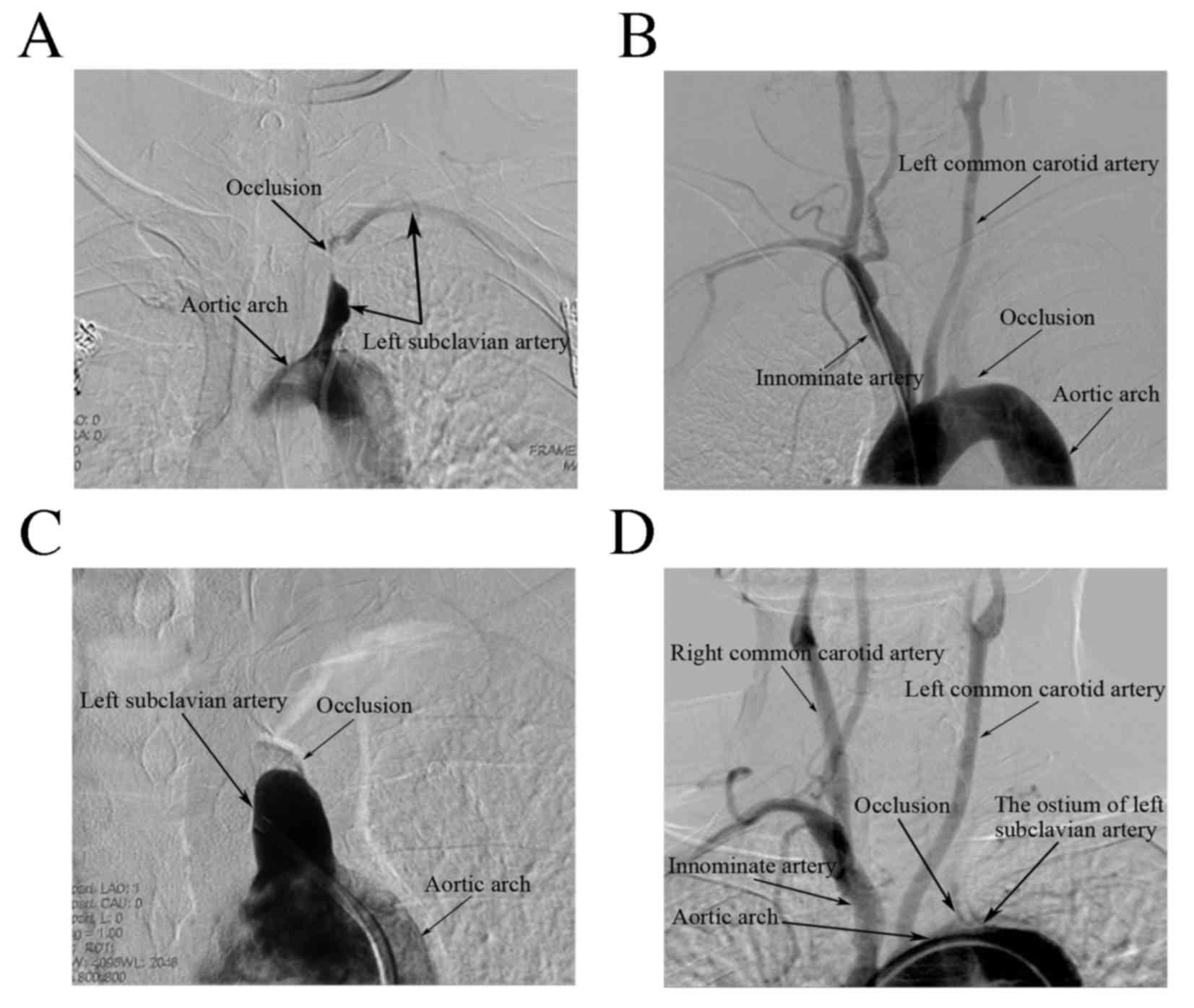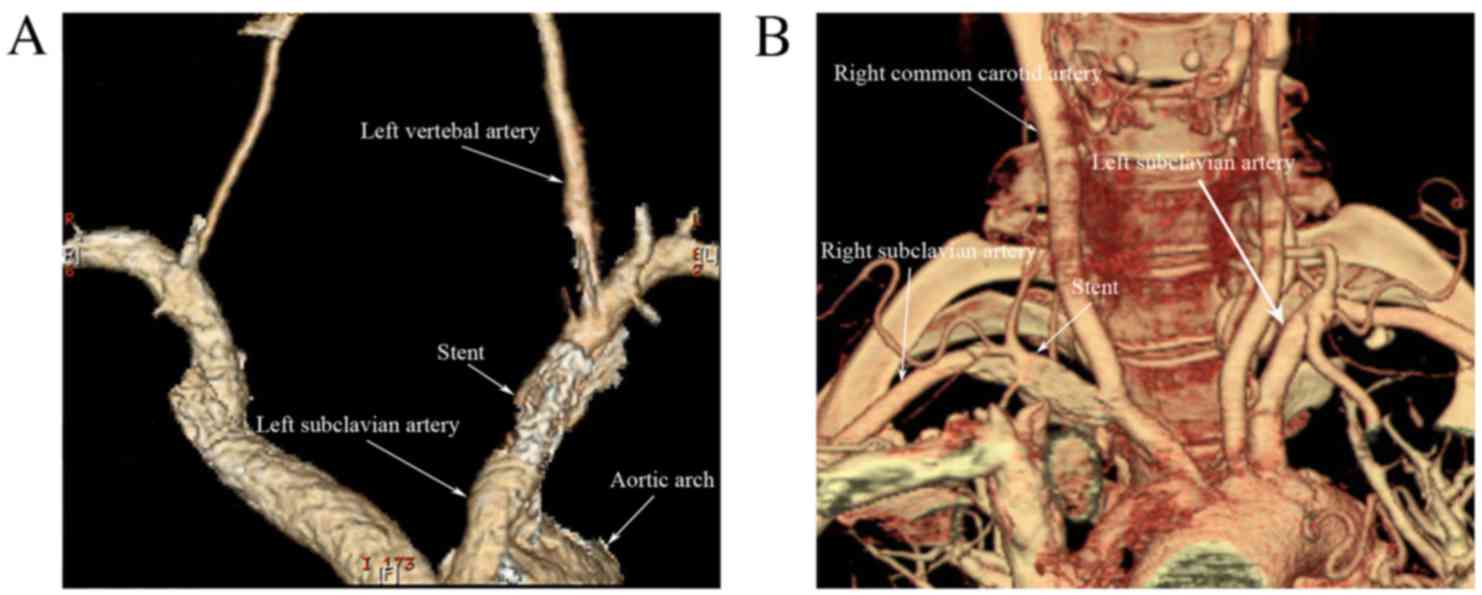|
1
|
Aiello F and Morrissey NJ: Open and
endovascular management of subclavian and innominate arterial
pathology. Semin Vasc Surg. 24:31–35. 2011. View Article : Google Scholar : PubMed/NCBI
|
|
2
|
Brott TG, Halperin JL, Abbara S, Bacharach
JM, Barr JD, Bush RL, Cates CU, Creager MA, Fowler SB, Friday G, et
al: 2011
ASA/ACCF/AHA/AANN/AANS/ACR/ASNR/CNS/SAIP/SCAI/SIR/SNIS/SVM/SVS
guideline on the management of patients with extracranial carotid
and vertebral artery disease. A report of the American college of
cardiology Foundation/American heart association task force on
practice guidelines, and the American stroke association, American
association of neuroscience nurses, American association of
neurological surgeons, American college of radiology, American
society of neuroradiology, congress of neurological surgeons,
society of atherosclerosis imaging and prevention, society for
cardiovascular angiography and interventions, society of
interventional radiology, society of neurointerventional surgery,
society for vascular medicine, and society for vascular surgery.
Circulation. 124:e54–e130. 2011.PubMed/NCBI
|
|
3
|
Modarai B, Ali T, Dourado R, Reidy JF,
Taylor PR and Burnand KG: Comparison of extra-anatomic bypass
grafting with angioplasty for atherosclerotic disease of the
supra-aortic trunks. Br J Surg. 91:1453–1457. 2004. View Article : Google Scholar : PubMed/NCBI
|
|
4
|
Delaney CP, Couse NF, Mehigan D and
Keaveny TV: Investigation and management of subclavian steal
syndrome. Br J Surg. 81:1093–1095. 1994. View Article : Google Scholar : PubMed/NCBI
|
|
5
|
Satti SR, Golwala SN, Vance AZ and Tuerff
SN: Subclavian steal: Endovascular treatment of total occlusions of
the subclavian artery using a retrograde transradial subintimal
approach. Interv Neuroradiol. 22:340–348. 2016. View Article : Google Scholar : PubMed/NCBI
|
|
6
|
Noguchi T, Miyazaki MDS, Morii I, Daikoku
S, Goto Y and Nonogi H: Percutaneous transluminal coronary
angioplasty of chronic total occlusions. Determinants of primary
success and long-term clinical outcome. Catheter Cardiovasc Interv.
49:258–264. 2000. View Article : Google Scholar : PubMed/NCBI
|
|
7
|
Palchik E, Bakken AM, Wolford HY, Saad WE
and Davies MG: Subclavian artery revascularization: an outcome
analysis based on mode of therapy and presenting symptoms. Ann Vasc
Surg. 22:70–78. 2008. View Article : Google Scholar : PubMed/NCBI
|
|
8
|
Seldinger SI: Catheter replacement of the
needle in percutaneous arteriography: A new technique. Acta Radiol.
39:368–376. 1953. View Article : Google Scholar : PubMed/NCBI
|
|
9
|
Bachman DM and Kim RM: Transluminal
dilatation for subclavian steal syndrome. Am J Roentgenol.
135:995–996. 1980. View Article : Google Scholar
|
|
10
|
Mathias K, Staiger J, Thron A, Spillner G,
Heiss HW and Konrad-Graf S: Percutaneous transluminal dilatation of
the subclavian artery (author's transl). Dtsch Med Wochenschr.
105:16–18. 1980.(In German). View Article : Google Scholar : PubMed/NCBI
|
|
11
|
Westerband A, Rodriguez JA, Ramaiah VG and
Diethrich EB: Endovascular therapy in prevention and management of
coronary-subclavian steal. J Vasc Surg. 38:699–704. 2003.
View Article : Google Scholar : PubMed/NCBI
|
|
12
|
De Vries JP, Jager LC, Van den Berg JC,
Overtoom TC, Ackerstaff RG, Van de Pavoordt ED and Moll FL:
Durability of percutaneous transluminal angioplasty for obstructive
lesions of proximal subclavian artery: Long-term results. J Vasc
Surg. 41:19–23. 2005. View Article : Google Scholar : PubMed/NCBI
|
|
13
|
Wang KQ, Wang ZG, Yang BZ, Yuan C, Zhang
WD, Yuan B, Xing T, Song SH, Li T, Liao CJ and Zhang Y: Long-term
results of endovascular therapy for proximal subclavian arterial
obstructive lesions. Chin Med J (Engl). 123:45–50. 2010.PubMed/NCBI
|
|
14
|
Paukovits TM, Lukács L, Bérczi V,
Hirschberg K, Nemes B and Hüttl K: Percutaneous endovascular
treatment of innominate artery lesions: A single-centre experience
on 77 lesions. Eur J Vasc Endovasc Surg. 40:35–43. 2010. View Article : Google Scholar : PubMed/NCBI
|
|
15
|
Higashimori A, Morioka N, Shiotani S,
Fujihara M, Fukuda K and Yokoi Y: Long-term results of primary
stenting for subclavian artery disease. Catheter Cardiovasc Interv.
82:696–700. 2013. View Article : Google Scholar : PubMed/NCBI
|
|
16
|
Bates MC, Broce M, Lavigne PS and Stone P:
Subclavian artery stenting: Factors influencing long-term outcome.
Catheter Cardiovasc Interv. 61:5–11. 2004. View Article : Google Scholar : PubMed/NCBI
|
|
17
|
Brountzos EN, Malagari K and Kelekis DA:
Endovascular treatment of occlusive lesions of the subclavian and
innominate arteries. Cardiovasc Intervent Radiol. 29:503–510. 2006.
View Article : Google Scholar : PubMed/NCBI
|
|
18
|
Brountzos EN, Petersen B, Binkert C,
Panagiotou I and Kaufman JA: Primary stenting of subclavian and
innominate artery occlusive disease: A single center's experience.
Cardiovasc Intervent Radiol. 27:616–623. 2004. View Article : Google Scholar : PubMed/NCBI
|
|
19
|
González A, Gil-Peralta A, González-Marcos
JR and Mayol A: Angioplasty and stenting for total symptomatic
atherosclerotic occlusion of the subclavian or innominate arteries.
Cerebrovasc Dis. 13:107–113. 2002. View Article : Google Scholar : PubMed/NCBI
|
|
20
|
Henry M, Henry I, Polydorou A, Polydorou A
and Hugel M: Percutaneous transluminal angioplasty of the
subclavian arteries. Int Angiol. 26:324–340. 2007.PubMed/NCBI
|
|
21
|
Martinez R, Rodriguez-Lopez J, Torruella
L, Ray L, Lopez-Galarza L and Diethrich EB: Stenting for occlusion
of the subclavian arteries. Technical aspects and follow-up
results. Texas Hear Inst J. 24:23–27. 1997.
|
|
22
|
Patel SN, White CJ, Collins TJ, Daniel GA,
Jenkins JS, Reilly JP, Morris RF and Ramee SR: Catheter-based
treatment of the subclavian and innominate arteries. Catheter
Cardiovasc Interv. 71:963–968. 2008. View Article : Google Scholar : PubMed/NCBI
|
|
23
|
Woo EY, Fairman RM, Velazquez OC, Golden
MA, Karmacharya J and Carpenter JP: Endovascular therapy of
symptomatic innominate-subclavian arterial occlusive lesions. Vasc
Endovascular Surg. 40:27–33. 2006. View Article : Google Scholar : PubMed/NCBI
|
|
24
|
Karpenko A, Starodubtsev V, Ignatenko P
and Gostev A: Endovascular treatment of the subclavian artery
steno-occlusive disease. J Stroke Cerebrovasc Dis. 26:87–93. 2017.
View Article : Google Scholar : PubMed/NCBI
|
|
25
|
Miyakoshi A, Hatano T, Tsukahara T,
Murakami M, Arai D and Yamaguchi S: Percutaneous transluminal
angioplasty for atherosclerotic stenosis of the subclavian or
innominate artery: Angiographic and clinical outcomes in 36
patients. Neurosurg Rev. 35:121–126. 2012. View Article : Google Scholar : PubMed/NCBI
|
|
26
|
Aziz F, Gravett MH and Comerota AJ:
Endovascular and open surgical treatment of brachiocephalic
arteries. Ann Vasc Surg. 25:569–581. 2011. View Article : Google Scholar : PubMed/NCBI
|
|
27
|
Sixt S, Rastan A, Schwarzwälder U,
Bürgelin K, Noory E, Schwarz T, Beschorner U, Frank U, Müller C,
Hauk M, et al: Results after balloon angioplasty or stenting of
atherosclerotic subclavian artery obstruction. Catheter Cardiovasc
Interv. 73:395–403. 2009. View Article : Google Scholar : PubMed/NCBI
|
|
28
|
AbuRahma AF, Bates MC, Stone PA, Dyer B,
Armistead L, Dean Scott L and Scott Lavigne P: Angioplasty and
stenting versus carotid-subclavian bypass for the treatment of
isolated subclavian artery disease. J Endovasc Ther. 14:698–704.
2007. View Article : Google Scholar : PubMed/NCBI
|
|
29
|
Przewlocki T, Kablak-Ziembicka A,
Pieniazek P, Musialek P, Kadzielski A, Zalewski J, Kozanecki A and
Tracz W: Determinants of immediate and long-term results of
subclavian and innominate artery angioplasty. Catheter Cardiovasc
Interv. 67:519–526. 2006. View Article : Google Scholar : PubMed/NCBI
|
|
30
|
Henry M, Amor M, Henry I, Ethevenot G,
Tzvetanov K and Chati Z: Percutaneous transluminal angioplasty of
the subclavian arteries. J Endovasc Surg. 6:33–41. 1999. View Article : Google Scholar : PubMed/NCBI
|
|
31
|
Sueoka BL: Percutaneous transluminal stent
placement to treat subclavian steal syndrome. J Vasc Interv Radiol.
7:351–356. 1996. View Article : Google Scholar : PubMed/NCBI
|
|
32
|
Criado FJ and Queral LA: The role of
angioplasty and stenting in the treatment of occlusive lesions of
supra-aortic trunks. J Mal Vasc. 21:(Suppl A). S132–S138. 1996.
|
|
33
|
Kumar K, Dorros G, Bates MC, Palmer L,
Mathiak L and Dufek C: Primary stent deployment in occlusive
subclavian artery disease. Cathet Cardiovasc Diagn. 34:281–285.
1995. View Article : Google Scholar : PubMed/NCBI
|
|
34
|
Mathias KD, Lüth I and Haarmann P:
Percutaneous transluminal angioplasty of proximal subclavian artery
occlusions. Cardiovasc Intervent Radiol. 16:214–218. 1993.
View Article : Google Scholar : PubMed/NCBI
|
|
35
|
Stone GW, Kandzari DE, Mehran R, Colombo
A, Schwartz RS, Bailey S, Moussa I, Teirstein PS, Dangas G, Baim
DS, et al: Percutaneous recanalization of chronically occluded
coronary arteries: A consensus document: Part I. Circulation.
112:2364–2372. 2005. View Article : Google Scholar : PubMed/NCBI
|
|
36
|
Sumitsuji S, Inoue K, Ochiai M, Tsuchikane
E and Ikeno F: Fundamental wire technique and current standard
strategy of percutaneous intervention for chronic total occlusion
with histopathological insights. JACC Cardiovasc Interv. 4:941–951.
2011. View Article : Google Scholar : PubMed/NCBI
|
|
37
|
Surmely JF, Katoh O, Tsuchikane E, Nasu K
and Suzuki T: Coronary septal collaterals as an access for the
retrograde approach in the percutaneous treatment of coronary
chronic total occlusions. Catheter Cardiovasc Interv. 69:826–832.
2007. View Article : Google Scholar : PubMed/NCBI
|
|
38
|
Ozawa N: A new understanding of chronic
total occlusion from a novel PCI technique that involves a
retrograde approach to the right coronary artery via a septal
branch and passing of the guidewire to a guiding catheter on the
other side of the lesion. Catheter Cardiovasc Interv. 68:907–913.
2006. View Article : Google Scholar : PubMed/NCBI
|
















